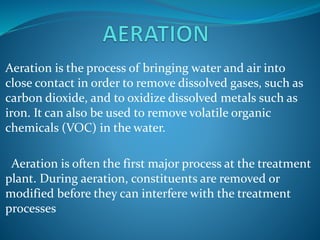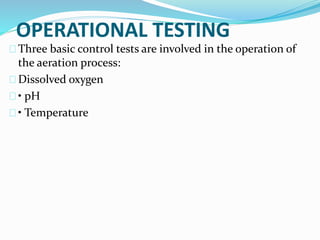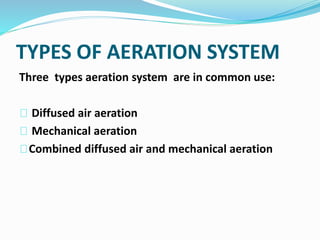Aeration
- 2. Aeration is the process of bringing water and air into close contact in order to remove dissolved gases, such as carbon dioxide, and to oxidize dissolved metals such as iron. It can also be used to remove volatile organic chemicals (VOC) in the water. Aeration is often the first major process at the treatment plant. During aeration, constituents are removed or modified before they can interfere with the treatment processes
- 3. Why We Use Aeration Oxidation of organic matter To increase dissolved oxygen content To reduce the concentration of taste and odor causing substances, such as hydrogen sulfide and various organic compounds, by volatilization / stripping or oxidation To oxidize iron and manganese, rendering them insoluble Flocculation of colloids in sewage influent To remove those compounds that may in some way interfere with or add to the cost of subsequent water treatment
- 4. HOW AERATION REMOVES OR MODIFIES CONSTITUENTS Sweeping or scrubbing action caused by the turbulence of water and air mixing together. Oxidizing certain metals and gases
- 5. DISCUSSION OF CHEMICAL SUBSTANCES AFFECTED BY AERATION Volatile organic chemicals, such as benzene, found in gasoline, or trichloroethylene, dichloroethylene etc Carbon dioxide • Hydrogen sulfide (rotten-egg odor) • Methane (flammable) • Iron (will stain clothes and fixtures) • Manganese (black stains) Various chemicals causing taste and odor
- 6. METHODS OF AERATION Passing water through air Passing air through water Water can be exposed to air by spraying or by distributing it in such a way that small particles or thin sheets of water come in contact with the air. Water can also aerated by pumping large volumes of air through the water.
- 7. WATER INTO AIR Cascade Aerators A cascade aerator consists of a series of steps that the water flows over. In all cascade aerators, aeration is accomplished in the splash zones. Cascade aerators can be used to oxidize iron and to partially reduce dissolved gases.
- 8. Cone Aerators Cone aerators are used primarily to oxidize iron and manganese from the ferrous state to the ferric state prior to filtration. The water being pumped to the top of the cones and then being allowed to cascade down through the aerator.
- 9. Spray Aerators This type of aerator has one or more spray nozzles connected to a pipe manifold. Moving through the pipe under pressure, the water leaves each nozzle in a fine spray and falls through the surrounding air, creating a fountain affect . In general, spray aeration is successful in oxidizing iron and manganese
- 10. AIR INTO WATER AIR STRIPPING It is quite effective in removing volatile organic chemicals (VOCs) from water. VOCs may be carcinogens. (eg of VOCs are benzene from gasoline and trichloroethylene from dry cleaning establishments) It can be accomplished by letting the water flow over cascade aerators or in specially designed air-stripping towers. In these, water is allowed to flow down over a support medium or packing contained in the tower, while air is being pumped into the bottom of the tower.
- 12. COMMON OPERATING PROBLEMS Super saturation(which may cause corrosion or air binding in filters ) Slow removal of the hydrogen sulfide from the towers Algae production, Clogged filters Overuse of energy.
- 13. OPERATIONAL TESTING Three basic control tests are involved in the operation of the aeration process: Dissolved oxygen • pH • Temperature
- 14. TYPES OF AERATION SYSTEM Three types aeration system are in common use: Diffused air aeration Mechanical aeration Combined diffused air and mechanical aeration
- 15. Diffuse aerators: A common way to aerate water is via diffused air. In these systems air is pumped through some sort of diffuser to generate small bubbles. These diffusers are porous ceramics, cloth or plastic. Types of diffused aeration: Fine bubble Coarse bubble Efficiency of fine bubble aeration is 10 to 20 times greater than that of coarse bubble diffused aeration system
- 17. FINE BUBBLE AERATION SYSTEM: DIAMETRE ---- approx 2mm to 2.5 mm small diameter so more surface area per unit volume Coarse bubble aerators:- They have slightly lower aeration efficiency than fine bubble aerators, but cheaper in cost and less liable to clogging and do not require filtration of air.
- 18. GUIDE FOR CHOOSING AN AERATION SYSTEM COST SERVICE CONDITIONS VERSATILITY MECHANICAL DESIGN
- 19. DIFFUSED AERATION MECHANICAL AERATION 1. Superior Mixing a) full dept mixing for any depth b) full basin utilization Limited mixing depth Limited energy location- poor distribution 2. Major Energy Saving Approx 40% energy saving vs. splash type surface aerators Low energy demand High energy cost High energy demand 3. Possible Flexibility Can turn down or throttle entire system Loss of air when unit are turn off No throttling possible 4. Capital Cost If used in deep basin very economical Short payback period If used in deep basin very costly Comparatively high payback period.
- 20. ADVANTAGES OF DIFFUSED AERATION TECHNOLOGY: 1.) High oxygen transfer rate. 2.)Simple installation. 3.)Lowers energy costs. 4.Capable of bring connected to both round & square pipes. 5.)Fully flooded pipes made with eco-friendly poly-propylene. 6.)Available in usable length of up to 2 meters.




















